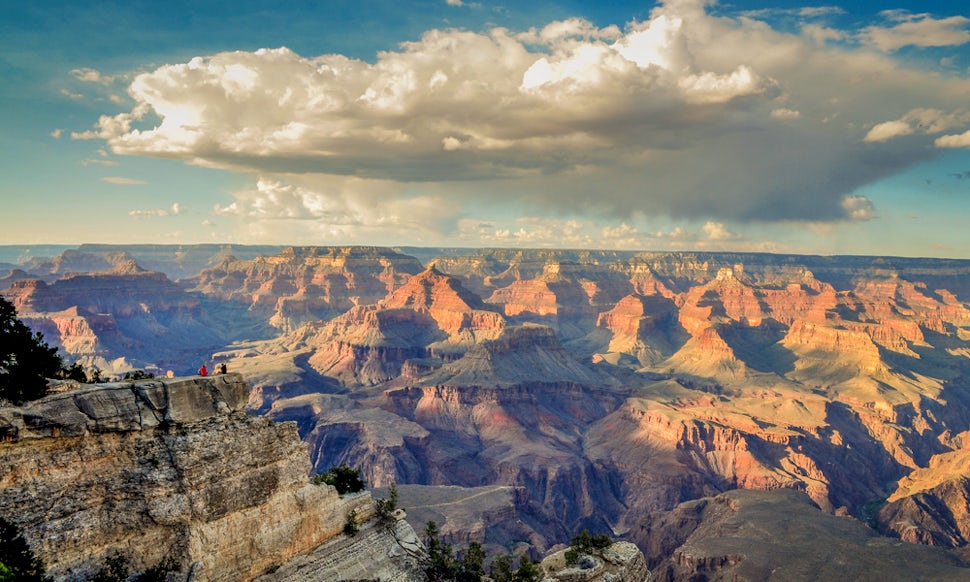5 Things I Learned Trail Running The Grand Canyon Rim-To-Rim-To-Rim
Challenge yourself in some of the most incredible scenery in the world.

The Rim 2 Rim 2 Rim, or the R3, is a double-crossing of the Grand Canyon in a single setting. Endurance hikers, ultra-runners, and athletes of all ages and skill levels attempt this feat year-round. The undertaking involves over 40 miles and 11,000 vertical feet of steep and rocky terrain with unmatched scenery for one very long, very challenging day…and I was somehow talked into trying it out.
The Grand Canyon rightfully earns its place as one of the Seven Wonders of the Natural World and as one of the most iconic parks in the U.S. This trip would be the first time I’d ever seen the canyon in person, and amusingly enough, I wouldn’t actually see it until three hours into our run when the sun began to rise. But those first few minutes when light began to trickle into the canyon were every bit as breathtaking as any postcard or calendar I’ve ever seen.

The Grand Canyon awed me, inspired me, and it taught me a few very important lessons about enjoying an outdoor adventure to its full potential.
1. It’s super important to do your research.
I had the pleasure of hiking with a park ranger on my ascent up the South Rim who let me use her as a pacer on my sluggish final miles. We both had a never-ending list of questions for each other about our contrasting perspectives on the R3, but the biggest one that stood out to me was: How much research did you do?
Turns out, I was more prepared than the majority of hikers and runners she’d seen. People neglected to check the park’s website for pipeline closures, track the weather to avoid extreme temperatures, or bring sufficient gear. This trouble ranged from finding themselves thirsty for miles, or with an ailment that seriously affected their chances of returning to safety.
Really, there’s no excuse not to over-plan and over-prepare for this type of trip, especially with the abundance of easily accessible information you can find about the Grand Canyon.
2. You can find community anywhere.
Community doesn’t just exist in the wild, it especially exists in the wild. Online, there were endless resources from small bloggers, to discussion boards, to organized groups dedicated to the promotion of the Rim to Rim to Rim. Canyon veterans and newbies ask and answer questions and share news, encouraging and allowing each other to plan the perfect GC trip.
The best part? This community doesn’t end online. When I was on the trail I met more runners, hikers, and backpackers that shared so much more knowledge than I ever could have Googled. I felt instantly bonded with the people around me, even without exchanging words. When you’re sharing a rock with a stranger, squeezing your mud-drenched feet into your trail runners after wading through a knee-deep trail flood, you’re establishing a connection that needs no explanation or expression.

3. Heed advice selectively.
I didn’t have to ask friends and family for advice when I told them I was attempting the R3. They felt obligated to give it anyways. I received countless opinions from folks I trusted, but who didn’t have a clue what they were talking about. From my first days of planning for the R3, my head was filled with horror stories of twisted ankles, rattlesnakes, water shortages, and personal failure.
That’s where this community became so important to my physical and mental preparation. Listening to advice from runners who had done double, triple, and quadruple crossing of the Grand Canyon made me feel exponentially better about my own ability. Though, this confidence probably took longer to develop than it should have.
4. Self-doubt will eat you alive.
I was stressed out to no end during the weeks leading up to this trip. I had never completed a marathon, and here I was about to do double that. Combined with the anxious counsel I received from friends, self-doubt constantly weighed on me and made the planning process leading up to the Grand Canyon to be strenuous and exhausting.
This number I had built up in my head - 46 miles - seemed increasingly larger, until I broke it down. Getting over my fears and allowing myself some credit was the first step to having the time of my life on the trail.
5. It’s not as hard as it seems.
Like doubting ourselves, humans have an innate sense to overexaggerate obstacles and underestimate their own personal abilities. I found myself doing just that, until I discovered that the Grand Canyon trails were equivalent to the mountains I was used to hiking - only inverted.
By comparing the canyon to what I was familiar with, moving at a pace I knew I could maintain, and keeping a large reserve of strength and energy for the final push back up the south Rim, I found the feat totally manageable. With the right gear, physical training, and nutrition preparation, it truly was a cinch.
I walked away from this experience blister-free and full of lessons learned thanks to the people and resources I found along the way. Maybe next year I’ll be able to pass on some of this newfound knowledge when I return for a second shot.

Cover photo: Rob Witt
We want to acknowledge and thank the past, present, and future generations of all Native Nations and Indigenous Peoples whose ancestral lands we travel, explore, and play on. Always practice Leave No Trace ethics on your adventures and follow local regulations. Please explore responsibly!
Do you love the outdoors?
Yep, us too. That's why we send you the best local adventures, stories, and expert advice, right to your inbox.







